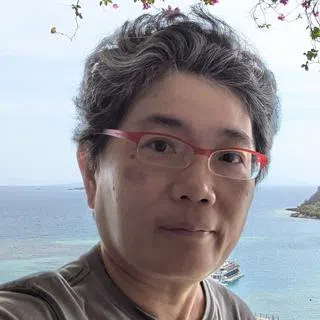[Photos] The road less travelled: China’s ancient Tea Horse Road
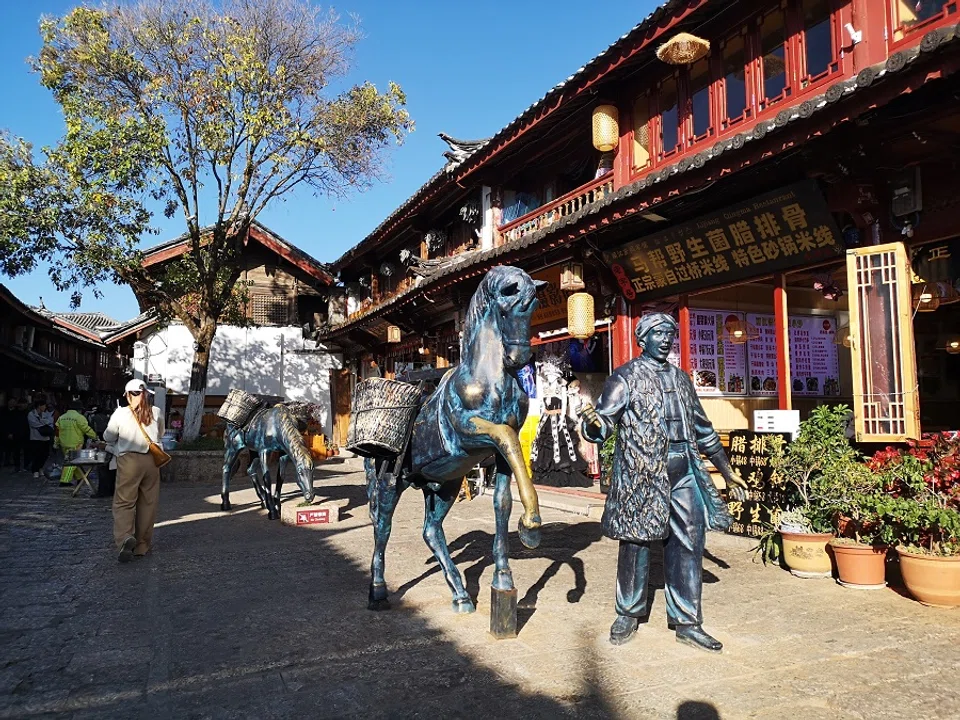
On a journey traversing the ancient Tea Horse Road in southwest China, writer Ng Kong Ling walks in the footsteps of tea-horse caravan traders and takes in breathtaking mountain views.
(All photos courtesy of Ng Kong Ling.)
As I sought out a unique experience amid China’s booming and oversaturated tourism industry, I thought of the ancient Tea Horse Road — a trade route that spanned southwest China. I had assumed that the horse caravans that once plied the route were ancient history, so I was surprised to encounter a real life porter who still traverses the ancient trail.
Gu Ronggui is the 18th-generation successor of the Tongxinfu caravan. He began working with his grandfather at the age of four, driving horses and transporting goods and cargo westward from Lijiang to Tibet to be traded. A round trip took several months; over more than a decade of arduous journeying, he crossed the Himalayas seven times. At 19, he returned to Lijiang, ending his career as a porter.
The dangers were indescribable. To cross raging rivers, for instance, he had to tie himself to a rope and zip-line across them, always prepared that he might at any moment be separated from his companions forever. Accidents did happen occasionally — he once fell into a mountain ravine and landed in freezing snow, but was fortunately found by a lead horse that kept him warm, giving him the strength to climb onto its back and survive.
Preserving the memories of horse caravans
These youthful brushes with death left an indelible mark on Gu. As roads and highways into Tibet gradually opened up, the horse caravan trade faded away. But Gu was unwilling to let the spirit of the caravans die, and has dedicated much of his life to collecting everyday artifacts, setting up a museum as another way to pass down the legacy of his ancestral profession.
The Tongxinfu Horse Caravan Museum (同心阜马帮博物馆) opened in late 2021, becoming a new attraction in Lijiang Old Town. The museum showcases heirlooms kept by the Gu family, along with old artifacts and photos. Visitors are always welcome; pick up any item and Gu himself will personally narrate the story behind it.
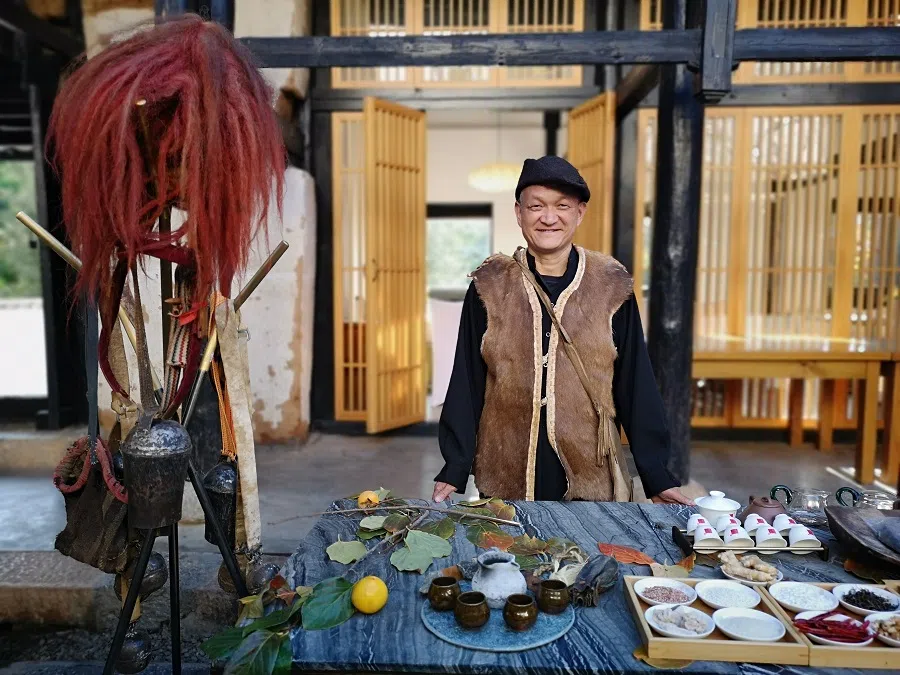
I met Gu at the historical Lijiang Old Town, described as the “last horse caravan porter”. I thought he must have been in his 70s or 80s at least, but I later found out that he is 55, close to my own age. Those distant, almost legendary experiences that we spoke of had actually happened in my time.
Since ancient times, residents of Sichuan and Yunnan relied on horse caravans for transportation, which enabled them to barter tea for horses, medicine and so on with Tibetan communities.
The history of the Tea Horse Road
The Tea Horse Road originated from the tea-horse trade markets in the southwest frontier of ancient China. It rose in the Tang and Song dynasties and flourished in the Ming and Qing dynasties, and was as well known as the Silk Road. Spanning thousands of kilometres, it was one of the most crucial roads in China’s southwest borderlands, with two main routes: the Sichuan-Tibet route starting from Ya’an in Sichuan, and the Yunnan-Tibet route beginning in the tea-producing region Pu’er, Yunnan. It crossed cold, high-altitude areas, into Lhasa in Tibet, then to Nepal, India and then all the way to Southeast Asia.
This ancient road was more than just a path; it was a vast network of rugged mountain terrain cutting through Sichuan, Yunnan, and Tibet. Since ancient times, residents of Sichuan and Yunnan relied on horse caravans for transportation, which enabled them to barter tea for horses, medicine and so on with Tibetan communities. Hoofbeats and jingling bells echoed through the perilous, remote trails for over a thousand years.
The Tongxinfu caravan originated in the middle of the Ming dynasty, starting from places like Lijiang and Benzilan in Yunnan and taking the long-distance Yunnan-Tibet route along the Tea Horse Road to India and Nepal. Along the way, the caravan travelled across the Meili Snow Mountains to Mangkang in Tibet, and even over the Himalayas. Once they reached their destination, they traded pu’er tea for goods like saffron and caterpillar fungus, which were then carried back.
By Gu’s time, improved transportation meant that horse caravans no longer made economic sense, and they stopped running. However, there are porters who still do short runs the traditional way in some remote mountainous stretches. The area’s historical influences can also be seen in modern transport infrastructure — large stretches of the modern Yunnan-Tibet and Sichuan-Tibet highways are actually based on the ancient Tea Horse Road.
The horse caravans and their stories may have faded away, but the Tea Horse Road itself has not. Now-distant hoofbeats and bells have given way to the footsteps of adventurers and travellers. Formerly bustling towns and relay stations along the road, meanwhile, have become storied destinations. In a time when everyone wants unique experiences, such places with history, culture and elements of travel and adventure inspire boundless imagination.
Goods of all kinds flowed through the street and people of different ethnic groups conducted business there, making it the liveliest area in Lijiang.
Relay station 1: Lijiang Old Town, UNESCO world heritage site and former transport hub
Unlike its name, modern-day Lijiang Old Town is not old, but a vibrant tourist city filled with visitors.
Its fresh look is the result of a remarkable revival. In 1996, a devastating earthquake reduced the entire town to rubble. During reconstruction, buildings were rebuilt according to strict regulations to preserve their original look, and they rose from the ruins fully restored. However, a lot of the town’s original residences collapsed in the earthquake, and many residents found new homes outside the old town. Today, the ancient stone-paved streets are lined with old-style buildings with shops, bars, restaurants, and guesthouses catering to tourists, creating a lively yet relaxed atmosphere.
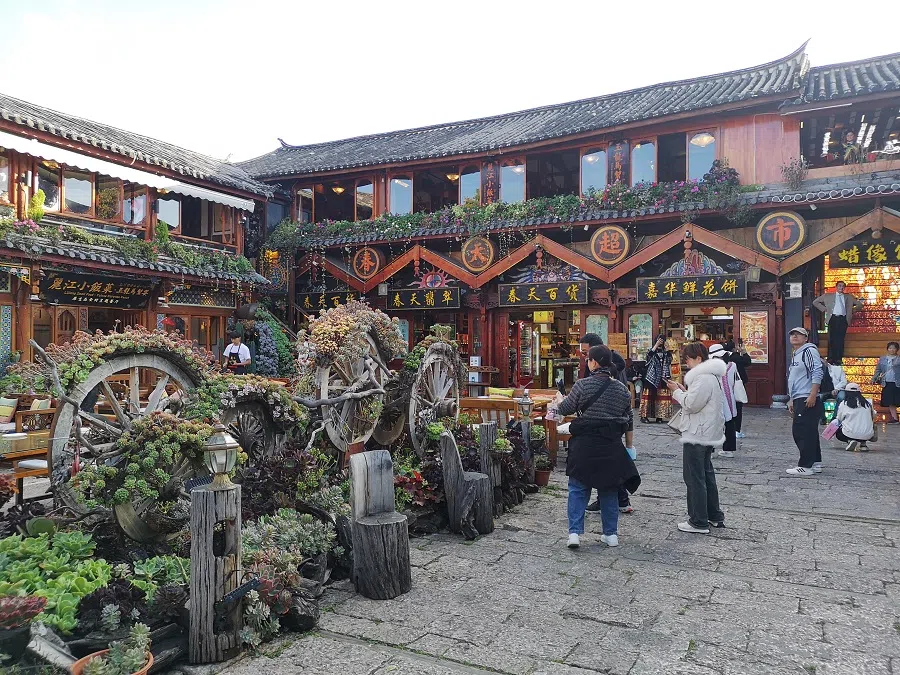

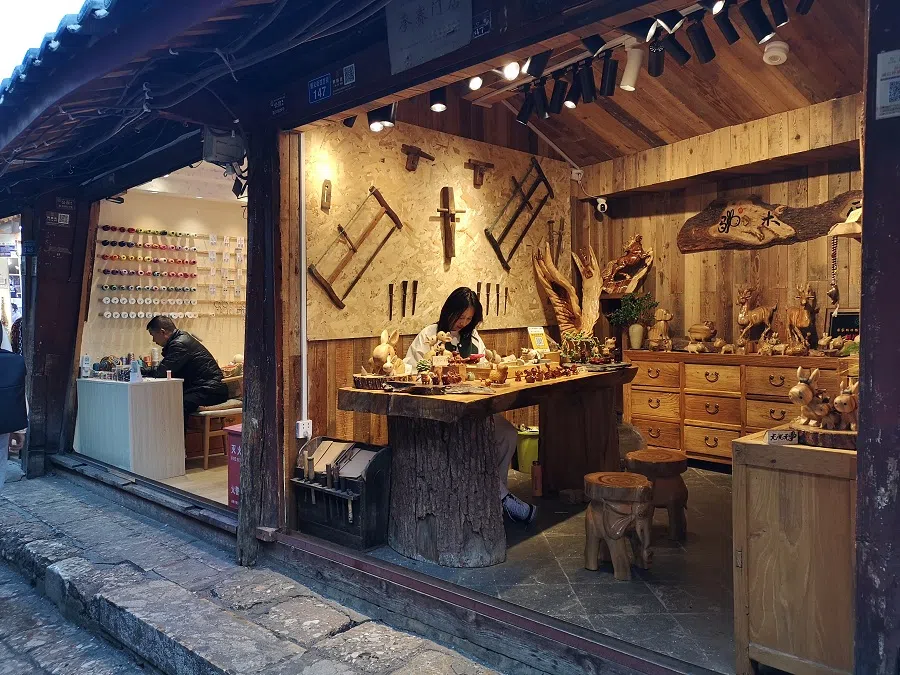
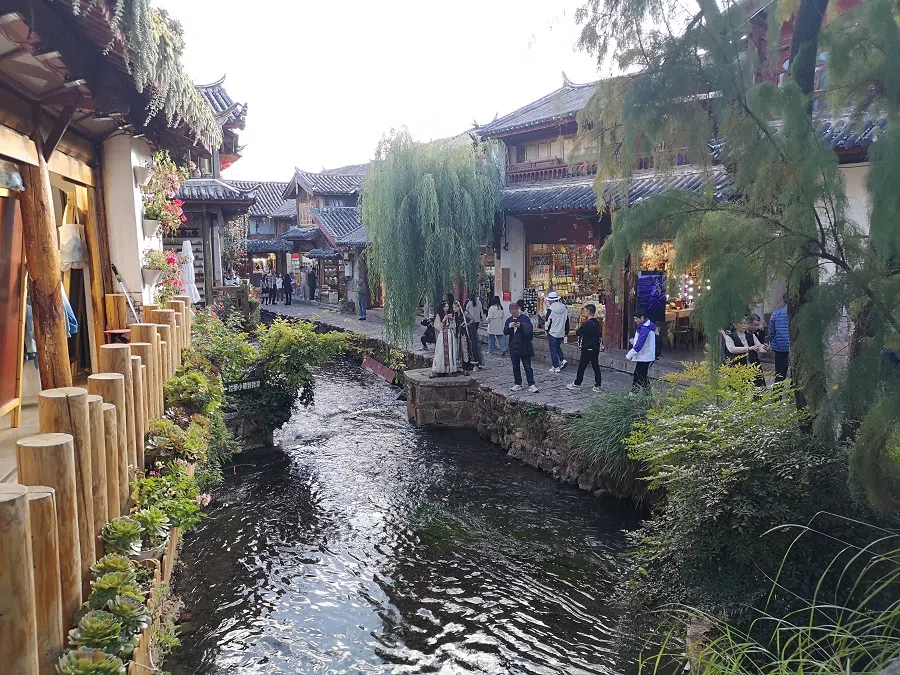

While the bustling streets may prompt lamentations that Lijiang has become too commercialised, Lijiang emerged precisely because of commerce along the Tea Horse Road. In other words, commercialisation is the very essence of the Old Town. In ancient times, Lijiang was not a city, but a trading market.
Lijiang was once a transportation hub and trade transit station along the Tea Horse Road, to which many great horse caravans flocked. During the Ming and Qing dynasties, the bustling Sifang Street in the heart of the old town was a key trading spot where merchants from various regions gathered. Goods of all kinds flowed through the street and people of different ethnic groups conducted business there, making it the liveliest area in Lijiang. The entire town developed around this street, with four main streets — each branching into smaller streets and alleys — radiating outward, forming the layout seen today.
In the mid-1980s, the descendants of horse caravan families bought back the site, which was reconstructed to resemble its original appearance after the earthquake and renamed Xingfu Old Teahouse.
Lijiang’s Xingfu Old Teahouse
Amid the array of shops in Lijiang, the century-old “Joyful antiquated teahouse” (幸福老茶庄, lit. Xingfu Old Teahouse) stands as a witness to the history of the Tea Horse Road. In the early 20th century, tea harvested in southern Yunnan during the spring was transported to Lijiang, and then to Tibet, India, Nepal, and other places via horse caravan. The Fuxingchang trading name was established, dealing in tea, cloth and medicinal herbs. In the 1950s, the buildings that housed the tea company were requisitioned by the government to set up the Xingfuyuan Elderly Home (幸福院养老院), with a teahouse along the street to subsidise its operations. In the mid-1980s, the descendants of horse caravan families bought back the site, which was reconstructed to resemble its original appearance after the earthquake and renamed Xingfu Old Teahouse.

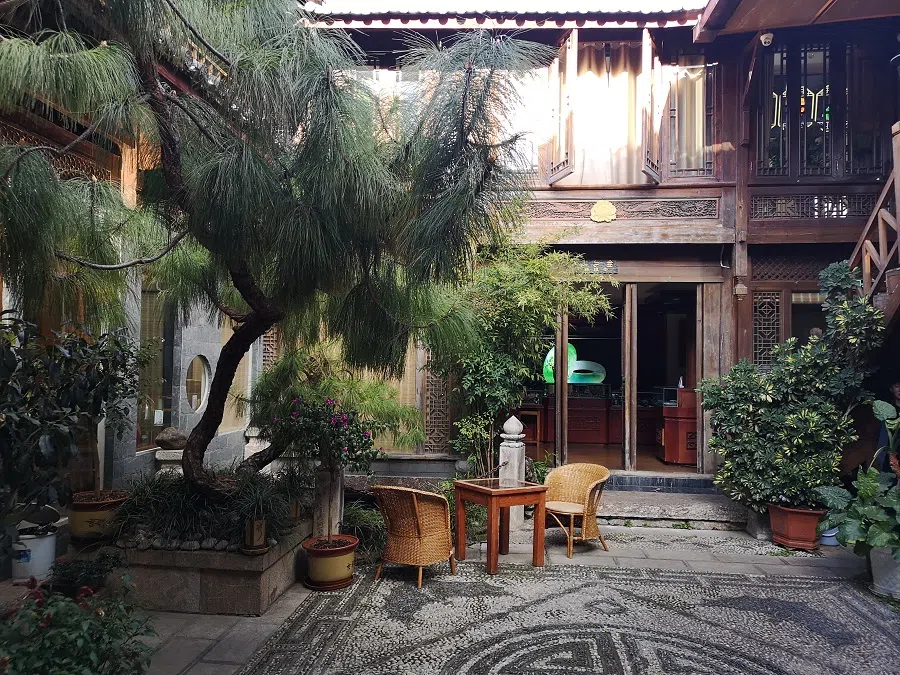

Today, Xingfu Old Teahouse caters to visitors while retaining its original spirit. Within the traditional Naxi-style building, there is a tea workshop showcasing the steps of making tea cakes. At the workshop, visitors can make their own tea cakes and design custom packaging to bring home as souvenirs. In the tea room upstairs, tea artisans introduce pu’er tea and tea leaves as they make tea and offer tastings, while sharing what they know of the Tea Horse Road and tea horses.
Compared to the harsh conditions once faced by horse caravaners, who camped in the snowy wilderness wearing only straw capes, Moonlight City is another world.
Relay station 2: Dukezong, a traditional Tibetan stop with modern conveniences
Since ancient times, Diqing has been a key corridor into Tibet, while Dukezong Ancient Town is an important checkpoint on the Tea Horse Road. Today, Dukezong is located in Shangri-La city. The newly developed Moonlight City — an extension on the outskirts of the old town — features modern hotels and commercial facilities, including LUX* Tea Horse Road Lijiang where I stayed during the trip.
At an altitude of around 3,300 metres, Dukezong’s ancient town and surrounding new district are built on the mountain slopes. Climbing up to that height makes one breathless, but the hotel’s advanced oxygen system provides each room with oxygen, so people can get their breath back once they are in the room. The rooms also have air conditioning and floor heating, to keep the room warm at night when the temperature drops. Compared to the harsh conditions once faced by horse caravaners, who camped in the snowy wilderness wearing only straw capes, Moonlight City is another world.
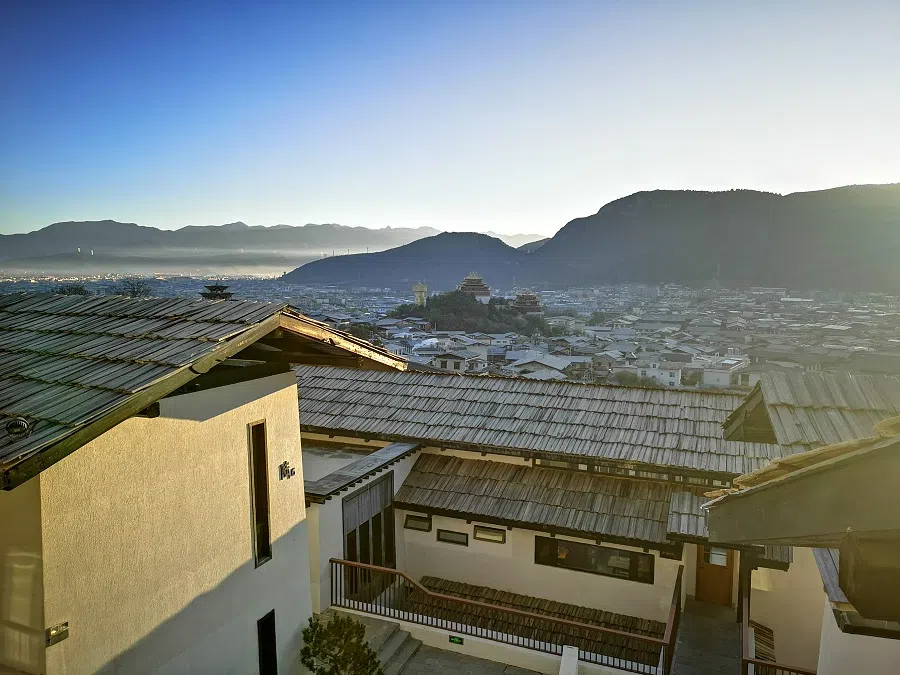
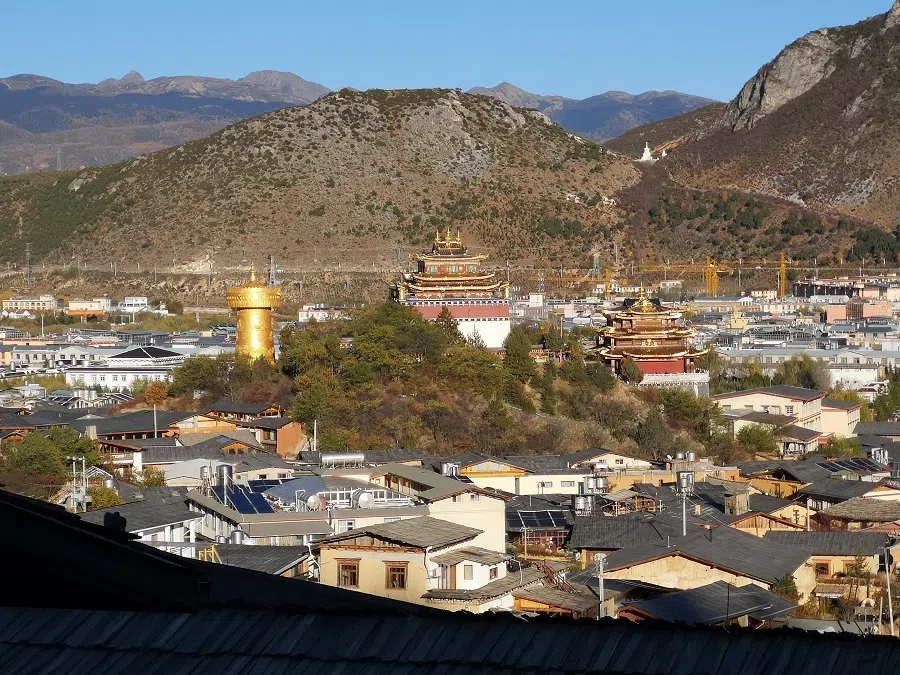
Gazing down at the ancient town from this modern space offers an entirely different perspective. A few steps from the hotel is Dukezong Old Town, reputed to be the largest and best-preserved cluster of Tibetan residences in China and more picturesque than Lijiang.
Dukezong is said to have been designed based on the Buddhist utopia Shambhala, also known as Shangri-La (hence the name of the city in which Dukezong is located). The city of Shangri-La used to be known as Gyalthang (or Zhongdian), but was officially renamed as Shangri-La in 2001 to attract more tourists, after the name was popularised in novels and films.
Experience traditional Tibetan culture
Dukezong Ancient Town is not very big, radiating outward from Dagui Mountain at its centre. The town’s traditional architecture is a blend of Tibetan and Han styles, restored with commercial polish and flair. Among the densely packed shops are many with Tibetan themes, such as Tibetan embroidery galleries, Thangka painting studios and eateries serving Tibetan cuisine.

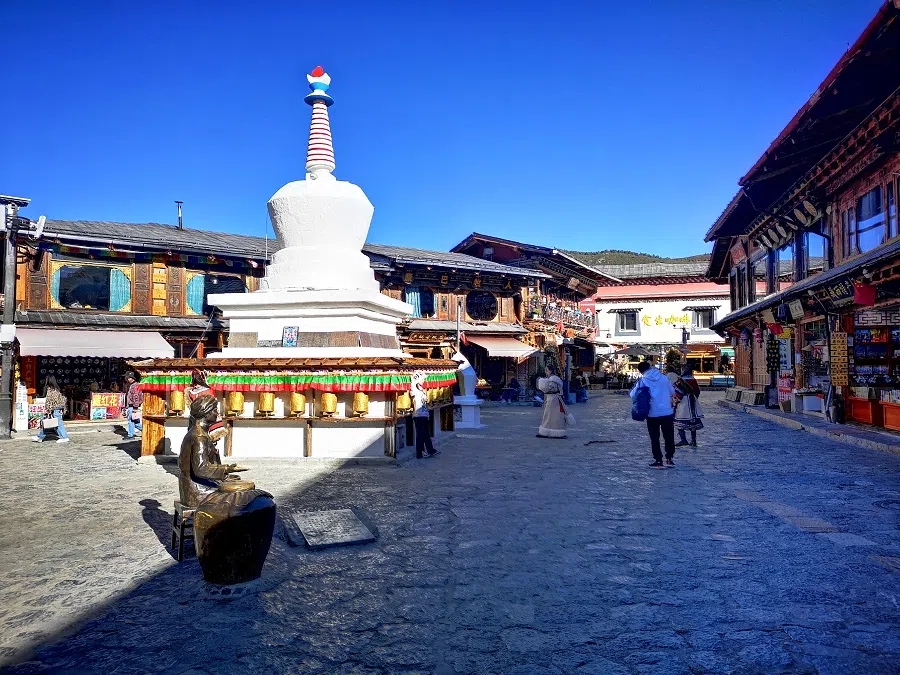

While the old buildings now look fresh, the original street layout remains intact. The uneven stone paths still bear the marks of horse hooves, evoking images of majestic horse caravans passing through — a jarring contrast to modern photo spots nearby, featuring phrases like “I’m waiting for you in Shangri-La”.
The most popular thing to do is to stroll through the alleys in rented traditional Tibetan attire, along with professional photographers who tell you the best poses and angles to stand at for the most Instagrammable photos.
Today, Benzilan is a little Tibetan town along the banks of the Jinsha (Yangtze) River. Its residents live in scattered mountain settlements, making it tough to tell the size and limits of the town. There are no busy streets...
Relay station 3: Benzilan, a hidden retreat
Deqin county in Diqing prefecture was the last stop within Yunnan for horse caravans along the Yunnan-Tibet route before entering Tibet, while Benzilan was a well-known ancient ferry crossing along the Tea Horse Road and a key point for caravans heading into Tibet or Sichuan from Yunnan. Merchants would stop here to rest and resupply before crossing the Baima Snow Mountains to continue northward into Tibet.
Today, Benzilan is a little Tibetan town along the banks of the Jinsha (Yangtze) River. Its residents live in scattered mountain settlements, making it tough to tell the size and limits of the town. There are no busy streets, totally unlike the touristy atmospheres of Lijiang and Dukezong.
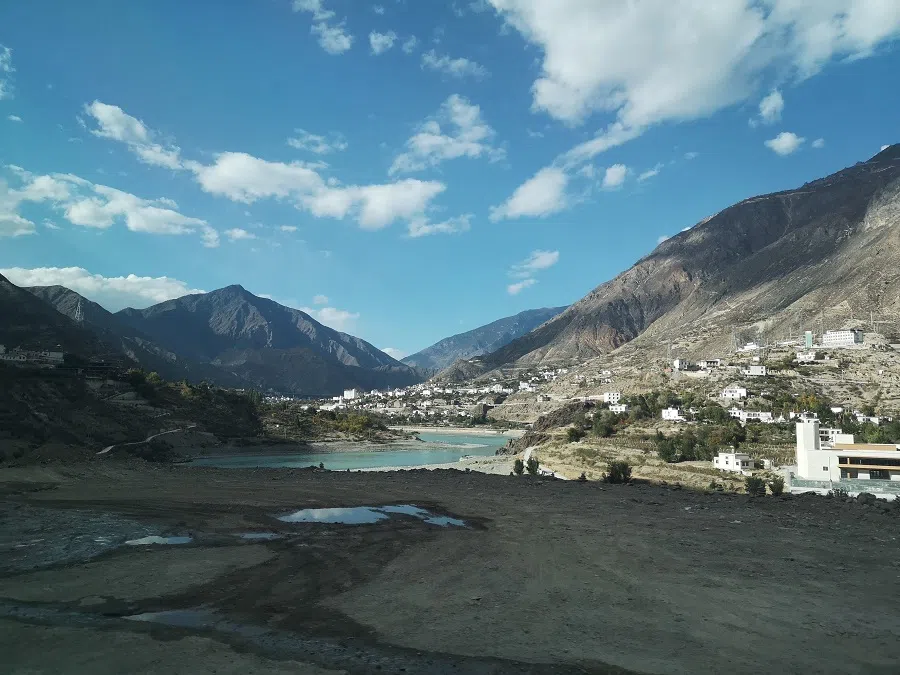
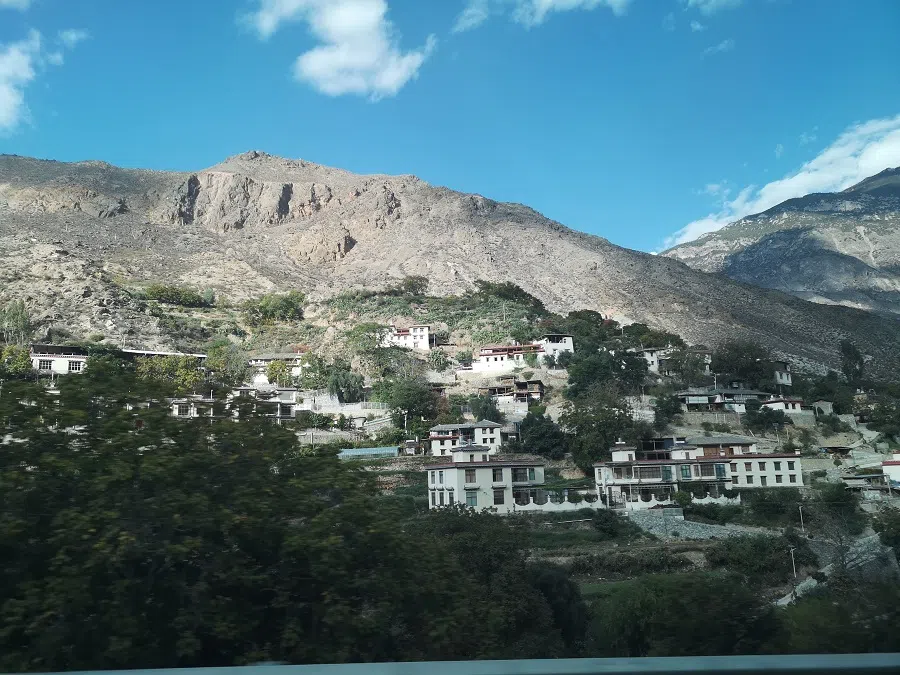

The LUX* Tea Horse Road collection also has a hotel here. It is not located in a popular tourist spot, but in a Tibetan village at the entrance to Benzilan, which used to be the village school. Looking out from the room, at one’s feet is the roaring Jinsha River, while all around are towering mountains. Across the river lies a village in Derong county in Sichuan’s Garze Tibetan Autonomous Prefecture. The village was historically reliant on horse caravans and the Tea Horse Road for its livelihood, just like Benzilan.
These were the sort of mountain roads that the horse caravans used to travel in as they crossed mountains and peaks on foot, with horses ahead of them and goods on their back.
Relax amidst the tranquility of Niding Village
Niding Village, a secluded mountain hamlet in Benzilan, is home to just over a dozen households. The staff at my hotel arranged a guided drive up the mountain; the mountain road was steep and winding, with sheer cliffs outside the window and the occasional yak blocking the road. Beyond the village there are no houses. The path continues upward to a pasture on the summit — this open grassland amid dense forests offers a view of Balagezong Mountain across the valley.


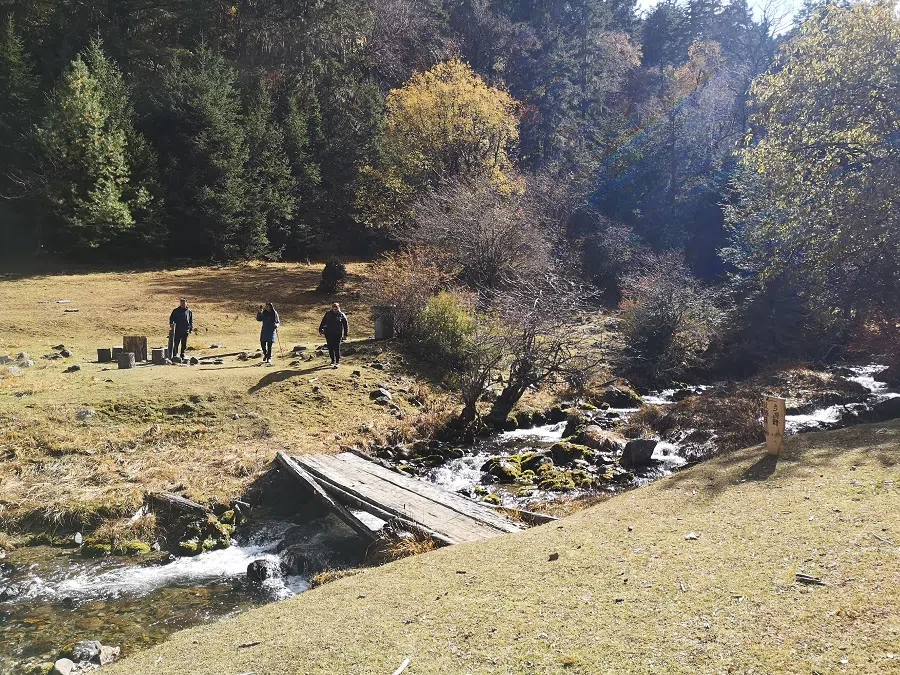
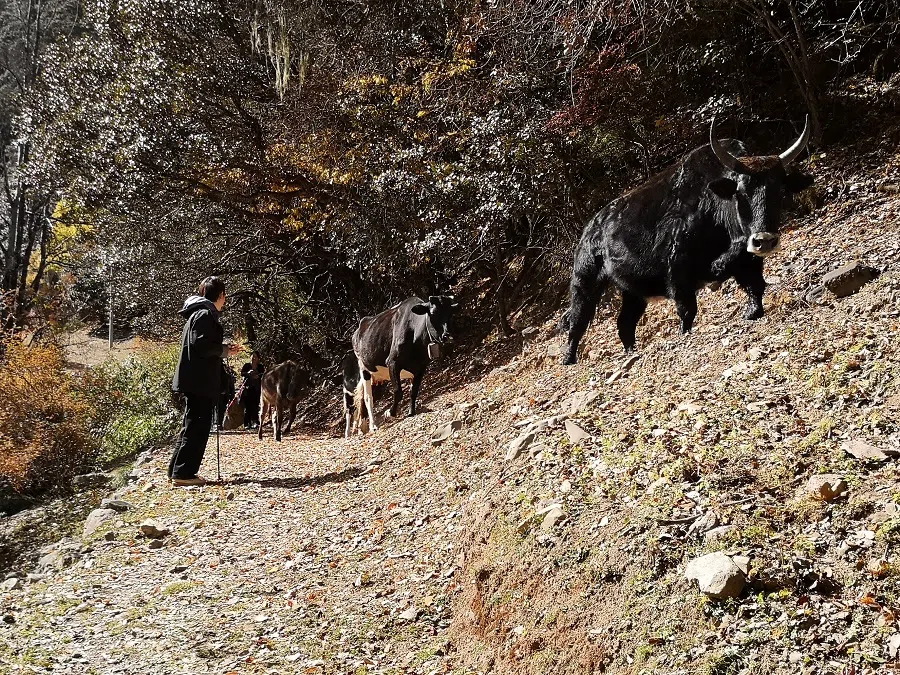
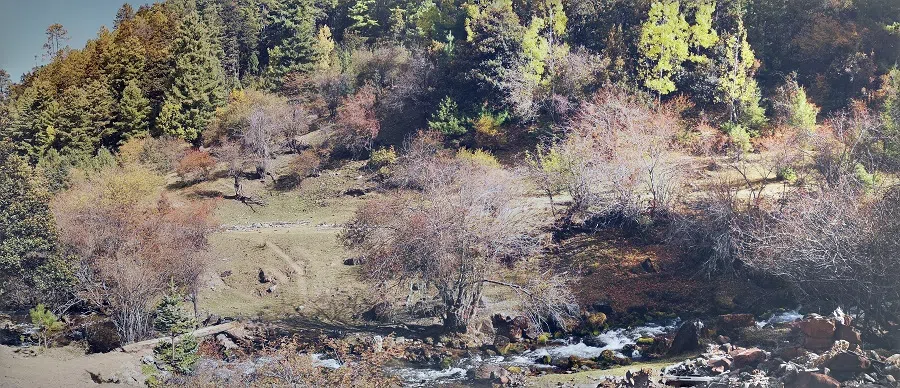
Today, the grassland is a picnic spot, where people can enjoy Tibetan-style hot pot chicken in little wooden cabins in the mountains, and get photos on the grass against the snow-capped mountains. And when the fun is done, they can hike through mountain forests and experience the Tea Horse Road of old.
These were the sort of mountain roads that the horse caravans used to travel in as they crossed mountains and peaks on foot, with horses ahead of them and goods on their back. Modern visitors, meanwhile, are well-fed and hydrated as they stroll through the forest paths and engage in forest bathing. In late autumn, tree foliage in the mountain forests are full of colour. Sunlight filters through the branches as it hits the yellow leaf-covered ground, amid babbling streams and the clink-clank of passing yak bells.
Today, the Tea Horse Road offers a laidback travel experience and a glimpse into the Road’s storied past, minus the physical and mental toil that used to be associated with travelling the road. All modern visitors have to do is to meander through quaint villages and lush forests, breathe in the phytoncides in the fresh mountain air, and immerse themselves in the region’s wild, rustic charm.
The “ancient” road may no longer be ancient, but it opens up a whole new world.
Secluded mountain retreats
What were once distant ancient trails, thought to exist only in imagination and nostalgia, surprisingly find a modern interpretation in the LUX* Tea Horse Road collection of hotels. The word “ancient” is omitted, and contemporary elements are obvious.
These hotels are located along the Tea Horse Road, including remote regions rarely visited by tourists, with the intent to revitalise these areas. Initially relatively unknown, they gained popularity during the pandemic when international travel was restricted, and domestic travellers sought out less crowded, distinctive destinations. From the original two hotels, the collection rapidly expanded to eight hotels and mountain retreats, scattered across Lijiang and the Greater Shangri-La area, forming a small loop along the Tea Horse Road.
The Tea Horse Road collection caters to niche travellers, with limited room numbers. Its focus is not on individual accommodations but rather on the entire journey and unique experiences along the way.
The accommodations are centred along the Yunnan-Tibet route, covering key Tea Horse Road locations like Lijiang, Benzilan and Dukezong. Newly launched retreats during the pandemic have drawn visitors to serene mountain escapes, such as the Sangushui Scenic Area, historically a place where caravaners on the Tea Horse Road would offer sacrifices and prayers for safe passage to Tibet and back. Another destination is the Lashi Lake Wetland, known for its lush grasslands and clear waters, which was once a crucial stop for Tea Horse Road caravans. Nearby, visitors can even enjoy horseback riding.
What was once a rugged and arduous journey along the ancient Tea Horse Road can now be explored with modern conveniences, comfortable accommodations and easy transportation. The “ancient” road may no longer be ancient, but it opens up a whole new world.
This article was first published in Lianhe Zaobao as “传奇不遥远 古韵今犹在 茶马古道新体验”.
